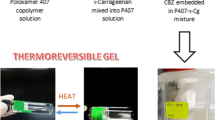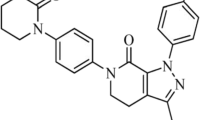Abstract
The nasal cavity represents a suitable administration route both for local and systemic treatments. Conventional nasal formulations (liquid, solid, semisolid) show a limited residence time responsible for an incomplete drug absorption with consequent impaired therapeutic efficacy. In situ nasal gels represent a suitable formulative strategy able to overcome this problem. These formulations are liquid at room temperature, making an easy administration, and become gel once in the nasal cavity. This is possible thanks to the use of polymers able to form a viscous gel under specific stimuli as temperature, pH, ions in the nasal fluid. The chapter illustrates the evolution from conventional nasal formulations to innovative in situ gel delivery systems and the advantages of such formulations. It presents also recent approaches, based on the combination of in situ gels with nanocarriers, useful to protect the drug either improve the biopharmaceutical properties and promote a controlled release. The safety aspects have been examined as well.
Access this chapter
Tax calculation will be finalised at checkout
Purchases are for personal use only
Similar content being viewed by others
References
Council of Europe – EDQM. European Pharmacopoeia, 10th Edition; 2020.
World Health Organization – WHO. The International Pharmacopoeia, Ninth Edition; 2019.
Illum L. Nasal drug delivery - possibilities, problems and solutions. J Control Release. 2003;87(1–3):187–98.
Mantaj J, Vllasaliu D. Recent advances in the oral delivery of biologics. Pharm J. 2020;304:7933.
Costantino HR, Illum L, Brandt G, Johnson PH, Quay SC. Intranasal delivery: physicochemical and therapeutic aspects. Int J Pharm. 2007;337(1–2):1–24.
Illum L. Transport of drugs from the nasal cavity to the central nervous system. Eur J Pharm Sci. 2000;11(1):1–18.
Misra A, Jogani V, Jinturkar K, Vyas T. Recent patents review on intranasal administration for CNS drug delivery. Recent Pat Drug Deliv Formul. 2008;2(1):25–40.
Washington N, McGlashan JA, Jackson SJ, Bush D, Pitt KG, Rawlins DA, Gill DA. The effect of nasal patency on the clearance of radiolabeled saline in healthy volunteers. Pharm Res. 2000;17(6):733–6.
Mygind N, Dahl R. Anatomy, physiology and function of the nasal cavities in health and disease. Adv Drug Deliv Rev. 1998;29(1–2):3–12.
Agnihotri VV, Pardeshi CV, Surana SJ. A current update on advanced drug delivery devices for nasal and pulmonary administration. In: Drug delivery devices and therapeutic systems, 1st ed. New York: Elsevier Inc.; 2021, pp. 213–245.
Khatri K, Jain S, Shilpi S. Nasal in-situ gel: an approach to enhance therapeutic benefits of the drug. Drug Deliv Lett. 2020;10(2):85–95.
Nele V, Wojciechowski JP, Armstrong JPK, Stevens MM. Tailoring gelation mechanisms for advanced hydrogel applications. Adv Funct Mater. 2020;30(42):2002759.
Paul A, Fathima K, Nair SC. Intra nasal in situ gelling system of lamotrigine using ion activated Mucoadhesive polymer. Open Med Chem J. 2017;11:222–44.
Chen W, Li R, Zhu S, Ma J, Pang L, Ma B, et al. Nasal timosaponin BII dually sensitive in situ hydrogels for the prevention of Alzheimer’s disease induced by lipopolysaccharides. Int J Pharm. 2020;30(578):119115.
Nižić L, Ugrina I, Špoljarić D, Saršon V, Kučuk MS, Pepić I, et al. Innovative sprayable in situ gelling fluticasone suspension: development and optimization of nasal deposition. Int J Pharm. 2019;563:445–56.
Turabee MH, Jeong TH, Ramalingam P, Kang JH, Ko YT. N,N,N-trimethyl chitosan embedded in situ Pluronic F127 hydrogel for the treatment of brain tumor. Carbohydr Polym. 2019;203:302–9.
Uppuluri CT, Ravi PR, Dalvi AV, Shaikh SS, Kale SR. Piribedil loaded thermo-responsive nasal in situ gelling system for enhanced delivery to the brain: formulation optimization, physical characterization, and in vitro and in vivo evaluation. Drug Deliv Transl Res. 2021;11(3):909–26.
Sosnik A, Seremeta KP. Polymeric hydrogels as technology platform for drug delivery applications. Gels. 2017;3(3):25.
Yurtdaş-Kırımlıoğlu G. A promising approach to design thermosensitive in situ gel based on solid dispersions of desloratadine with Kolliphor® 188 and Pluronic® F127, vol. 147. J Therm Anal Calorim; 2021. p. 1307.
Sridhar V, Tiwari A, Wairkar S, Gupta GL, Gaud R. Pramipexole thermosensitive nasal gel for experimental parkinsonism in rats. J Drug Deliv Sci Technol. 2020;59:101954.
Verekar RR, Gurav SS, Bolmal U. Thermosensitive mucoadhesive in situ gel for intranasal delivery of Almotriptan malate: formulation, characterization, and evaluation. J Drug Deliv Sci Technol. 2020;58:101778.
Shelke S, Pathan I, Shinde G, Agrawal G, Damale M, Chouthe R, Panzade P, Kulkarni D. Poloxamer-based in situ nasal gel of naratriptan hydrochloride deformable vesicles for brain targeting. BioNanoScience. 2020;10(2):633–48.
Rao M, Agrawal DK, Shirsath C. Thermoreversible mucoadhesive in situ nasal gel for treatment of Parkinson’s disease. Drug Dev Ind Pharm. 2017;43(1):142–50.
Agrawal M, Saraf S, Saraf S, Dubey SK, Puri A, Gupta U, et al. Stimuli-responsive In situ gelling system for nose-to-brain drug delivery. J Control Release. 2020;327:235–65.
Jaworski Z, Spychaj T, Story A, Story G. Carbomer microgels as model yield-stress fluids. Rev Chem Eng. 2021:1–35.
Bedford JG, Caminschi I, Wakim LM. Intranasal delivery of a chitosan-hydrogel vaccine generates nasal tissue resident memory CD8+ T cells that are protective against influenza virus infection. Vaccine. 2020;8(4):572.
Chen Y, Liu Y, Xie J, Zheng Q, Yue P, Chen L, et al. Nose-to-brain delivery by nanosuspensions-based in situ gel for breviscapine. Int J Nanomedicine. 2020;15:10435–51.
Dalvi AV, Ravi PR, Uppuluri CT, Mahajan RR, Katke SV, Deshpande VS. Thermosensitive nasal in situ gelling systems of rufinamide formulated using modified tamarind seed xyloglucan for direct nose-to-brain delivery: design, physical characterization, and in vivo evaluation. J Pharm Investig. 2021;51:199–211.
Pharma Holdings AS. A double-blind, placebo-controlled, interventional parallel group study to evaluate the antiviral effect of a single nasal application of LTX-109 3% gel, in comparison to placebo gel, in subjects with COVID-19 infection. EU Clinical Trials Register; 15/02/2021; TrialID: EUCTR2021-000455-39-SE.
Rabiee N, Ahmadi S, Afshari R, Khalaji S, Rabiee M, Bagherzadeh M, et al. Polymeric nanoparticles for nasal drug delivery to the brain: relevance to Alzheimer’s disease. Adv Ther. 2021;4(3):2000076.
Touitou E, Natsheh H, Boukeileh S, Awad R. Short onset and enhanced analgesia following nasal administration of non-controlled drugs in nanovesicular systems. Pharmaceutics. 2021;13(7):978.
Fan Y, Chen M, Zhang J, Maincent P, Xia X, Wu W. Updated progress of nanocarrier-based intranasal drug delivery systems for treatment of brain diseases. Crit Rev Ther Drug Carrier Syst. 2018;35(5):433–67.
Kammoun AK, Khedr A, Hegazy MA, Almalki AJ, Hosny KM, Abualsunun WA. Formulation, optimization, and nephrotoxicity evaluation of an antifungal in situ nasal gel loaded with voriconazole–clove oil transferosomal nanoparticles. Drug Deliv. 2021;28(1):2229–40.
Aderibigbe BA. In situ-based gels for nose to brain delivery for the treatment of neurological diseases. Pharmaceutics. 2018;10(2):40.
Deshkar SS, Jadhav MS, Shirolkar SV. Development of carbamazepine nanostructured lipid carrier loaded thermosensitive gel for intranasal delivery. Adv Pharm Bull. 2021;11(1):150–62.
Teaima MH, El Mohamady AM, El-Nabarawi MA, Mohamed AI. Formulation and evaluation of niosomal vesicles containing ondansetron HCL for trans-mucosal nasal drug delivery. Drug Dev Ind Pharm. 2020;46(5):1–43.
Hong SS, Oh KT, Choi HG, Lim SJ. Liposomal formulations for nose-to-brain delivery: recent advances and future perspectives. Pharmaceutics. 2019;11(10):540.
Adnet T, Groo AC, Picard C, Davis A, Corvaisier S, Since M, et al. Pharmacotechnical development of a nasal drug delivery composite nanosystem intended for alzheimer’s disease treatment. Pharmaceutics. 2020;12(3):251.
Costa CP, Barreiro S, Moreira JN, Silva R, Almeida H, Sousa Lobo JM, et al. In vitro studies on nasal formulations of nanostructured lipid carriers (NLC) and solid lipid nanoparticles (SLN). Pharmaceuticals. 2021;14(8):711.
Mignani S, Shi X, Karpus A, Majoral JP. Non-invasive intranasal administration route directly to the brain using dendrimer nanoplatforms: an opportunity to develop new CNS drugs. Eur J Med Chem. 2021;209:112905.
Vecsernyés M, Fenyvesi F, Bácskay I, Deli MA, Szente L, Fenyvesi É. Cyclodextrins, blood-brain barrier, and treatment of neurological diseases. Arch Med Res. 2014;45(8):711–29.
Mura P, Mennini N, Nativi C, Richichi B. In situ mucoadhesive-thermosensitive liposomal gel as a novel vehicle for nasal extended delivery of opiorphin. Eur J Pharm Biopharm. 2018;122:54–61.
El-Shenawy AA, Mahmoud RA, Mahmoud EA, Mohamed MS. Intranasal in situ gel of Apixaban-loaded Nanoethosomes: preparation, optimization, and in vivo evaluation. AAPS PharmSciTech. 2021;22(4):147.
Hosny KM, Alhakamy NA. Nasal gel loaded with amphotericin nanotransferosomes as antifungal treatment for fungal sinusitis. Pharmaceutics. 2021;13(1):35.
Omar MM, Eleraky NE, El Sisi AM, Hasan OA. Development and evaluation of in-situ nasal gel formulations of nanosized transferosomal sumatriptan: design, optimization, in vitro and in vivo evaluation. Drug Des Devel Ther. 2019;13:4413–30.
Abdelnabi DM, Abdallah MH, Elghamry HA. Buspirone hydrochloride loaded in situ Nanovesicular gel as an anxiolytic nasal drug delivery system: in vitro and animal studies. AAPS PharmSciTech. 2019;20(134):1–14.
Cunha S, Forbes B, Lobo JMS, Silva AC. Improving drug delivery for alzheimer’s disease through nose-to-brain delivery using nanoemulsions, nanostructured lipid carriers (NLC) and in situ hydrogels. Int J Nanomedicine. 2021;16:4373–90.
Cunha S, Forbes B, Lobo JMS, Silva AC. Thermosensitive nasal in situ gels of lipid-based Nanosystems to improve the treatment of Alzheimer’s disease. PRO. 2020;78(1):37.
Trapani A, De Giglio E, Cometa S, Bonifacio MA, Dazzi L, Di Gioia S, et al. Dopamine-loaded lipid based nanocarriers for intranasal administration of the neurotransmitter: a comparative study. Eur J Pharm Biopharm. 2021;167:189–200.
Sabir F, Ismail R, Csoka I. Nose-to-brain delivery of antiglioblastoma drugs embedded into lipid nanocarrier systems: status quo and outlook. Drug Discov Today. 2020;25(1):185–94.
Gadhave DG, Kokare CR. Nanostructured lipid carriers engineered for intranasal delivery of teriflunomide in multiple sclerosis: optimization and in vivo studies. Drug Dev Ind Pharm. 2019;45:839–51.
Davidov-Pardo G, McClements DJ. Resveratrol encapsulation: designing delivery systems to overcome solubility, stability and bioavailability issues. Trends Food Sci Technol. 2014;38(2):88–103.
Rajput AP, Butani SB. Resveratrol anchored nanostructured lipid carrier loaded in situ gel via nasal route: formulation, optimization and in vivo characterization. J Drug Deliv Sci Technol. 2019;51:214–23.
Qu Y, Li A, Ma L, Iqbal S, Sun X, Ma W, et al. Nose-to-brain delivery of disulfiram nanoemulsion in situ gel formulation for glioblastoma targeting therapy. Int J Pharm. 2021;597:120250.
Elsenosy FM, Abdelbary GA, Elshafeey A, Elsayed I, Fares AR. Brain targeting of duloxetine hcl via intranasal delivery of loaded cubosomal gel: in vitro characterization, ex vivo permeation, and in vivo biodistribution studies. Int J Nanomedicine. 2020;15:9517–37.
Xie H, Li L, Sun Y, Wang Y, Gao S, Tian Y, et al. An available strategy for nasal brain transport of nanocomposite based on PAMAM dendrimers via in situ gel. Nano. 2019;9(2):147.
Ahmed OAA, Badr-Eldin SM. In situ misemgel as a multifunctional dual-absorption platform for nasal delivery of raloxifene hydrochloride: formulation, characterization, and in vivo performance. Int J Nanomedicine. 2018;13:6325–35.
Cirri M, Maestrelli F, Nerli G, Mennini N, D’ambrosio M, Luceri C, Mura PA. Development of a cyclodextrin-based mucoadhesive-thermo-sensitive in situ gel for clonazepam intranasal delivery. Pharmaceutics. 2021;13(7):969.
Quadir M, Zia H, Needham TE. Toxicological implications of nasal formulations. Drug Deliv. 1999;6(4):227–42.
Keller LA, Merkel O, Popp A. Intranasal drug delivery: opportunities and toxicologic challenges during drug development. Drug Deliv Transl Res. 2021;25:1–23.
Behl CR, Pimplaskar HK, Sileno AP, DeMeireles J, Romeo VD. Effects of physicochemical properties and other factors on systemic nasal drug delivery. Adv Drug Deliv Rev. 1998;29(1–2):89–116.
Scherließ R. Nasal formulations for drug administration and characterization of nasal preparations in drug delivery. Ther Deliv. 2020;11(3):183–91.
Mackie AR, Goycoolea F, Menchicchi B, Caramella CM, Saporito F, Lee S, et al. Innovative methods and applications in mucoadhesion research. Macromol Biosci. 2017;17(8):1600534.
Menchicchi B, Fuenzalida JP, Bobbili KB, Hensel A, Swamy MJ, Goycoolea FM. Structure of chitosan determines its interactions with mucin. Biomacromolecules. 2014;15(10):3550–8.
Rossi S, Ferrari F, Bonferoni MC, Caramella C. Characterization of chitosan hydrochloride-mucin rheological interaction: influence of polymer concentration and polymer:mucin weight ratio. Eur J Pharm Sci. 2001;12(4):479–85.
Wang Y, Jiang S, Wang H, Bie H. A mucoadhesive, thermoreversible in situ nasal gel of geniposide for neurodegenerative diseases. PLoS One. 2017;12(12):e0189478.
Author information
Authors and Affiliations
Corresponding author
Editor information
Editors and Affiliations
Rights and permissions
Copyright information
© 2023 The Author(s), under exclusive license to Springer Nature Switzerland AG
About this chapter
Cite this chapter
Pagano, C., Perioli, L., Ricci, M. (2023). Novel Approaches in Nasal In Situ Gel Drug Delivery. In: Pathak, Y.V., Yadav, H.K.S. (eds) Nasal Drug Delivery. Springer, Cham. https://doi.org/10.1007/978-3-031-23112-4_12
Download citation
DOI: https://doi.org/10.1007/978-3-031-23112-4_12
Published:
Publisher Name: Springer, Cham
Print ISBN: 978-3-031-23111-7
Online ISBN: 978-3-031-23112-4
eBook Packages: Biomedical and Life SciencesBiomedical and Life Sciences (R0)




